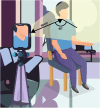Capturing the pulse: a state-of-the-art review on camera-based jugular vein assessment
- PMID: 38420308
- PMCID: PMC10898581
- DOI: 10.1364/BOE.507418
Capturing the pulse: a state-of-the-art review on camera-based jugular vein assessment
Abstract
Heart failure is associated with a rehospitalisation rate of up to 50% within six months. Elevated central venous pressure may serve as an early warning sign. While invasive procedures are used to measure central venous pressure for guiding treatment in hospital, this becomes impractical upon discharge. A non-invasive estimation technique exists, where the clinician visually inspects the pulsation of the jugular veins in the neck, but it is less reliable due to human limitations. Video and signal processing technologies may offer a high-fidelity alternative. This state-of-the-art review analyses existing literature on camera-based methods for jugular vein assessment. We summarize key design considerations and suggest avenues for future research. Our review highlights the neck as a rich imaging target beyond the jugular veins, capturing comprehensive cardiac signals, and outlines factors affecting signal quality and measurement accuracy. Addressing an often quoted limitation in the field, we also propose minimum reporting standards for future studies.
© 2023 The Author(s).
Conflict of interest statement
The authors declare no conflicts of interest.
Figures



Similar articles
-
Upper body central venous catheters in pediatric cardiac surgery.Paediatr Anaesth. 2013 Nov;23(11):980-8. doi: 10.1111/pan.12261. Epub 2013 Sep 19. Paediatr Anaesth. 2013. PMID: 24088201
-
Noninvasive measurement of central venous pressure by neck inductive plethysmography.Chest. 1991 Aug;100(2):371-5. doi: 10.1378/chest.100.2.371. Chest. 1991. PMID: 1864108
-
Endovascular laser therapy for varicose veins: an evidence-based analysis.Ont Health Technol Assess Ser. 2010;10(6):1-92. Epub 2010 Apr 1. Ont Health Technol Assess Ser. 2010. PMID: 23074409 Free PMC article.
-
Prospects of jugular venous pulse assessment.JNMA J Nepal Med Assoc. 2010 Jul-Sep;49(179):247-54. JNMA J Nepal Med Assoc. 2010. PMID: 22049834 Review.
-
[Estimation of the jugular venous pressure].Ned Tijdschr Geneeskd. 2016;160:A9600. Ned Tijdschr Geneeskd. 2016. PMID: 26758360 Review. Dutch.
Cited by
-
Low-cost camera-based assessment of venous hemodynamics in the lower limbs: a study on young healthy volunteers.Biomed Opt Express. 2025 Jan 10;16(2):520-534. doi: 10.1364/BOE.547794. eCollection 2025 Feb 1. Biomed Opt Express. 2025. PMID: 39958860 Free PMC article.
-
Introduction to the feature issue: Advances in Optical Biosensors for Biomedical Applications.Biomed Opt Express. 2024 Apr 19;15(5):3183-3190. doi: 10.1364/BOE.527613. eCollection 2024 May 1. Biomed Opt Express. 2024. PMID: 38855687 Free PMC article.
-
Non-Contact Vision-Based Techniques of Vital Sign Monitoring: Systematic Review.Sensors (Basel). 2024 Jun 19;24(12):3963. doi: 10.3390/s24123963. Sensors (Basel). 2024. PMID: 38931747 Free PMC article.
-
Non-contact imaging of the neck for monitoring cardiopulmonary clinic patients.Biomed Opt Express. 2025 Jun 20;16(7):2860-2874. doi: 10.1364/BOE.543645. eCollection 2025 Jul 1. Biomed Opt Express. 2025. PMID: 40677816 Free PMC article.
